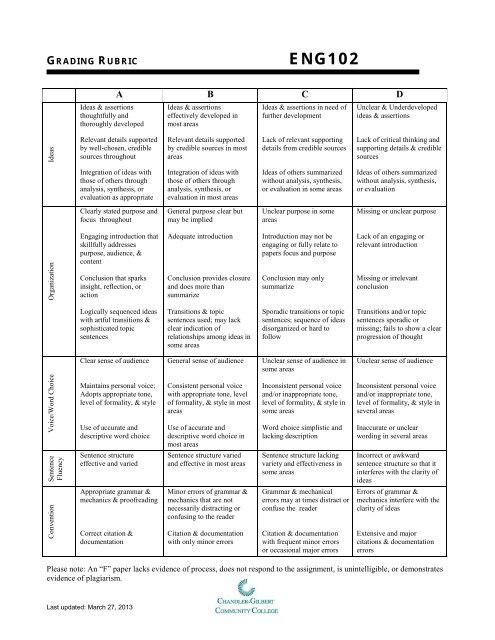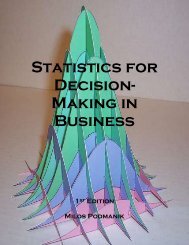English 102 Grading Rubric (Table Format)
English 102 Grading Rubric (Table Format)
English 102 Grading Rubric (Table Format)
Create successful ePaper yourself
Turn your PDF publications into a flip-book with our unique Google optimized e-Paper software.
GRADING RUBRIC<br />
ENG<strong>102</strong><br />
Ideas & assertions<br />
thoughtfully and<br />
thoroughly developed<br />
A B C D<br />
Ideas & assertions<br />
effectively developed in<br />
most areas<br />
Ideas & assertions in need of<br />
further development<br />
Unclear & Underdeveloped<br />
ideas & assertions<br />
Ideas<br />
Relevant details supported<br />
by well-chosen, credible<br />
sources throughout<br />
Relevant details supported<br />
by credible sources in most<br />
areas<br />
Lack of relevant supporting<br />
details from credible sources<br />
Lack of critical thinking and<br />
supporting details & credible<br />
sources<br />
Integration of ideas with<br />
those of others through<br />
analysis, synthesis, or<br />
evaluation as appropriate<br />
Integration of ideas with<br />
those of others through<br />
analysis, synthesis, or<br />
evaluation in most areas<br />
Ideas of others summarized<br />
without analysis, synthesis,<br />
or evaluation in some areas<br />
Ideas of others summarized<br />
without analysis, synthesis,<br />
or evaluation<br />
Clearly stated purpose and<br />
focus throughout<br />
General purpose clear but<br />
may be implied<br />
Unclear purpose in some<br />
areas<br />
Missing or unclear purpose<br />
Organization<br />
Engaging introduction that<br />
skillfully addresses<br />
purpose, audience, &<br />
content<br />
Conclusion that sparks<br />
insight, reflection, or<br />
action<br />
Adequate introduction<br />
Conclusion provides closure<br />
and does more than<br />
summarize<br />
Introduction may not be<br />
engaging or fully relate to<br />
papers focus and purpose<br />
Conclusion may only<br />
summarize<br />
Lack of an engaging or<br />
relevant introduction<br />
Missing or irrelevant<br />
conclusion<br />
Logically sequenced ideas<br />
with artful transitions &<br />
sophisticated topic<br />
sentences<br />
Transitions & topic<br />
sentences used; may lack<br />
clear indication of<br />
relationships among ideas in<br />
some areas<br />
Sporadic transitions or topic<br />
sentences; sequence of ideas<br />
disorganized or hard to<br />
follow<br />
Transitions and/or topic<br />
sentences sporadic or<br />
missing; fails to show a clear<br />
progression of thought<br />
Clear sense of audience<br />
General sense of audience<br />
Unclear sense of audience in<br />
some areas<br />
Unclear sense of audience<br />
Voice/Word Choice<br />
Maintains personal voice;<br />
Adopts appropriate tone,<br />
level of formality, & style<br />
Use of accurate and<br />
descriptive word choice<br />
Consistent personal voice<br />
with appropriate tone, level<br />
of formality, & style in most<br />
areas<br />
Use of accurate and<br />
descriptive word choice in<br />
most areas<br />
Inconsistent personal voice<br />
and/or inappropriate tone,<br />
level of formality, & style in<br />
some areas<br />
Word choice simplistic and<br />
lacking description<br />
Inconsistent personal voice<br />
and/or inappropriate tone,<br />
level of formality, & style in<br />
several areas<br />
Inaccurate or unclear<br />
wording in several areas<br />
Sentence<br />
Fluency<br />
Sentence structure<br />
effective and varied<br />
Sentence structure varied<br />
and effective in most areas<br />
Sentence structure lacking<br />
variety and effectiveness in<br />
some areas<br />
Incorrect or awkward<br />
sentence structure so that it<br />
interferes with the clarity of<br />
ideas<br />
Convention<br />
Appropriate grammar &<br />
mechanics & proofreading<br />
Correct citation &<br />
documentation<br />
Minor errors of grammar &<br />
mechanics that are not<br />
necessarily distracting or<br />
confusing to the reader<br />
Citation & documentation<br />
with only minor errors<br />
Grammar & mechanical<br />
errors may at times distract or<br />
confuse the reader<br />
Citation & documentation<br />
with frequent minor errors<br />
or occasional major errors<br />
Errors of grammar &<br />
mechanics interfere with the<br />
clarity of ideas<br />
Extensive and major<br />
citations & documentation<br />
errors<br />
Please note: An “F” paper lacks evidence of process, does not respond to the assignment, is unintelligible, or demonstrates<br />
evidence of plagiarism.<br />
Last updated: March 27, 2013
QUALITIES OF COLLEGE-LEVEL WRITING<br />
ENG<strong>102</strong><br />
RHETORICAL KNOWLEDGE<br />
• Focuses on a purpose and develops ideas thoughtfully and thoroughly with that purpose in<br />
mind.<br />
• Anticipates and addresses different audiences’ needs.<br />
• Demonstrates the writer’s knowledge or experience of the topic.<br />
• Begins in an engaging way appropriate to the writer's purpose and audience.<br />
• Effectively supports positions and assertions with relevant details, evidence and authority.<br />
• Sequences ideas logically and effectively for the purpose and the audience.<br />
• Concludes beyond summarizing to encourage insight, reflection, or action.<br />
• Writes with a tone that is appropriate for the purpose and audience.<br />
• Allows the reader to have a sense of interacting with the writer.<br />
CRITICAL THINKING<br />
• Uses writing and active reading to inquire, learn, think, and communicate.<br />
• Selects and evaluates appropriate primary and secondary sources.<br />
• Develops ideas with relevant details from well-chosen, appropriate sources.<br />
• Takes into consideration alternative viewpoints on the topic.<br />
• Moves beyond summarizing or reporting to integrating the writer’s ideas with those of others<br />
through analysis, synthesis, and evaluation.<br />
• Effectively integrates information from a variety of primary and secondary sources by<br />
summarizing, paraphrasing or quoting, appropriate to the purpose of the writing.<br />
KNOWLEDGE OF CONVENTIONS<br />
• Uses topic sentences and transitions to enhance coherence and unity.<br />
• Varies sentence structure to reflect the complexity of the writer’s ideas.<br />
• Uses grammar and mechanics appropriately.<br />
• Demonstrates careful proofreading by correcting typos and errors.<br />
• Avoids clichés, colloquialisms, slang, and convoluted language and instead uses college-level<br />
vocabulary to make the writing precise and lively.<br />
• Citations and documentation are placed and formatted correctly in MLA style.<br />
• Uses appropriate number and variety of sources according to assignment guidelines.<br />
• Demonstrates a match between sources cited in text and those listed in works cited page.<br />
Last updated: March 27, 2013
















